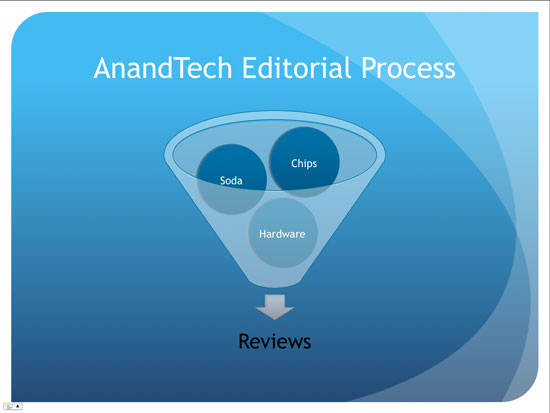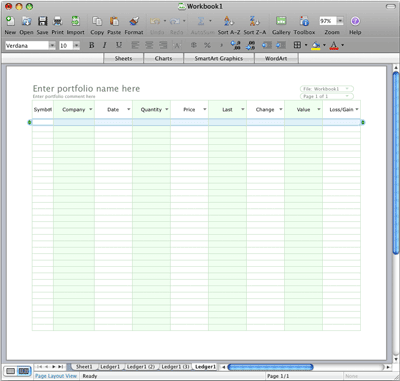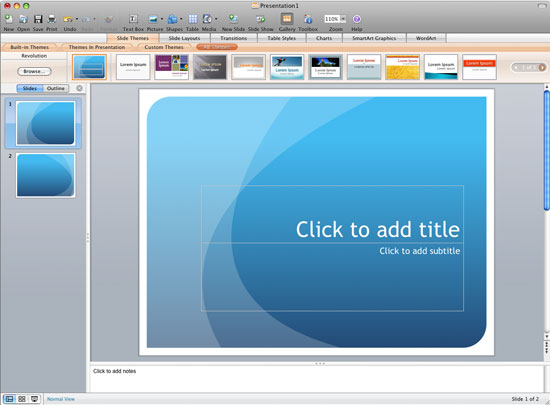The Other Office: Microsoft Office 2008 for Mac Review
by Ryan Smith on February 5, 2008 12:00 AM EST- Posted in
- Mac
Excel & PowerPoint
Next to Word, the rest of the core Office applications have not received the same kind of attention, with Microsoft clearly not having a clear goal for these applications like they did Word.
Excel is the most neglected, having gained very little and suffering the most from the loss of VBA. Excel’s big new feature for Office 2008 is ledger sheet templates, functioning as Excel’s version of Word’s publishing layout templates. These various ledger templates are pre-formatted to feature the types of columns appropriate for the ledger type, and any formulas such a ledger would need. Even more so than the Word page layout features, the ledger templates are clearly targeted towards home users and not business users.
Filling out Excel’s ribbon are WordArt, SmartArt, and the new charts. Office’s new charting abilities have more of a chance to shine here, as Excel is free of the uncomfortable bond between itself and Word when charts are summoned through Word. It’s hard to get particularly excited about a chart of all things, but Microsoft’s art team deserves credit here for coming up with some nice, modern graphics for charts in Office 2008 that are far better than some of the tired and blocky charts of Offices past.

Last but not least among the core Office applications is PowerPoint, which has found itself in an odd bind on the Mac in recent years. Since 2003 Apple has published its own presentation software, Keynote, the brainchild and reportedly favorite piece of Apple software for Steve Jobs. When visual flare is one of Apple’s strongest suits, Keynote is easily the biggest competitor to any single Office component on the market. Apple has put in every trick in the book in to Keynote, from OpenGL accelerated effects to integration with Apple’s media applications.
The bind for PowerPoint is trying to once again push PowerPoint ahead of Keynote; unlike word processing documents and spreadsheets, there’s little need to widely share presentations, which means Microsoft can’t bank on the fact that PowerPoint is still more popular because it’s also on Windows. Here the problem isn’t so much one of functionality but visuals, keynote is functionally very similar but gets such heavy usage on the Mac due to its superior visuals.
As a result and as has been the case with the rest of Office 2008, the changes for PowerPoint 2008 start with templates and artwork, many of the old templates have been thrown out and many more new ones introduced that stay with the theme of modernizing the graphics in Office and beating Apple at visual flare. The transitions have also been updated with the addition of several new transitions, including a few 3D transitions. Unfortunately for Microsoft they still aren’t using OpenGL here, which limits what they can further do with transitions; even a number of Keynote’s 2D transitions are using some kind of OpenGL effect that demonstrate so well Apple’s goal for visual flare. And while it seems petty to complain about PowerPoint’s transitions of all things, our own real world experience is that a showy transition may be the last thing keeping the audience drifting away, so at some level they do count.

A 3D cube transition midway through transition
SmartArt rounds out the major changes in PowerPoint’s visuals, and while it’s technically available in all 3 core Office applications it makes far more sense to discuss it here since its predominant use will be in PowerPoint. As we called it earlier, SmartArt is a series of simple & stylized diagramming elements that are used to show the relationships between data. PowerPoint has come with its own minimal flowchart/diagramming abilities for years (for more complex charting is Microsoft’s Visio, which isn’t on the Mac) but SmartArt isn’t a replacement or competitor for that functionality. Rather SmartArt’s pre-built diagrams serve to offer better looking diagrams that only need their text plugged in; in essence faster & shiner diagramming for a limited number of common cases.
Given how obtuse (and ugly) PowerPoint’s prior diagramming abilities were, we’d consider SmartArt a useful and meaningful addition to PowerPoint, with enough variety to keep from audiences getting too burnt out on the artwork too soon. It’s also one of the few things that will set PowerPoint 2008 apart from Keynote for now, although we’d bet on Apple introducing its own SmartArt implementation if it proves to be as useful as we suspect it to be.

PowerPoint has also received a
few new pieces of functionality, largely bringing it up to par with Keynote in
areas where it was lacking. PowerPoint now features some iPhoto integration,
allowing slideshows to be exported to iPhoto for distribution to users without
PowerPoint, or alternatively to iPods which can function as presentation
devices when a video-out kit is attached (obviously not with the special
effects, however). The Apple Remote is also supported now, giving PowerPoint
another option for controlling their presentations.












13 Comments
View All Comments
Rankin - Monday, February 11, 2008 - link
Does anyone know the performance of Word '08 and Endnote? About 6 people in my office are running Word '04 (v. 11.3.8) and Endnote X02 with OSX 10.4.11 and the response is terrible. On any document with Endnote references, the CPU jumps to 100% and pretty much stays there, with the fan screaming away, until it's minimised for >5mins or closed. This is totally unacceptable - it makes it impossible to even scroll through documents. Apple tech support just shrug (they can't say if it will be rectified with no emulation), Leopard doesn't help and we can't change from Endnote because all our PhD references are in there.Don't suppose I can convince anyone to do some tests on this to add to the review?
Gandalf90125 - Saturday, February 9, 2008 - link
"iWork is ... leaps and bounds better ... enough so that for the first time ever Microsoft has some real competition for office suites on the Mac."This is a silly comment. I don't think you are aware of Lotus 1-2-3 and WordPerfect for Macintosh. In the early to mid-1990s, both products were excellent and were serious challengers to Microsoft's offerings. In fact, when 1-2-3 was released, Excel (version 2.2 at the time) was clearly inferior to it. I don't mean to denigrate you or your review, but I think you ought not to make such comments unless you are familiar with the history of Macintosh business applications, a history that goes back almost 25 years.
Now, I expect that I will be challenged or flamed over this on the grounds that 1-2-3 and WordPerfect never constituted an actual "Suite", but that's just semantic baloney. Word processing and electronic spreadsheets have always been the workhorses of business software applications.
strikeback03 - Thursday, February 7, 2008 - link
These figures are great, esp. implying a connection between global warming and pirates. I'd guess the pirates being outrun by cruise ships is a bigger problem for them thoughhttp://www.cnn.com/2005/WORLD/africa/11/05/somalia...">http://www.cnn.com/2005/WORLD/africa/11/05/somalia...
hiromizu - Wednesday, February 6, 2008 - link
There's no mention of this important feature of remote Exchange/Outlook integration.Yawgm0th - Wednesday, February 6, 2008 - link
The article talks quite a bit about business use and how certain features (caused by lack of VBA support) are missing, mostly from Excel. This seems like a moot point, or at least the point that some of the missing features should not affect more than a few dozen -- if that many -- potential end-users of Office 2008 for Mac.What kind of business uses a Mac for accounting or a similar function based around Excel spreadsheets? I mean, one could make the argument that few business use a Mac in any function that will have use for Office, but Excel is a big stretch. No business hoping to profit would justify the cost of a Mac for use with Excel.
Ryan Smith - Wednesday, February 6, 2008 - link
One of my jobs prior to working for AnandTech was IT at a company using Macs near-exclusively (as exclusive as they could be, anyhow). You would be terrified what these people did with Excel spreadsheets and VBA, there were certainly better ways to do it but it was quite literally a matter of the whole thing having built out of Excel over the years.And this company isn't alone.
There will be plenty of Excel-addicted accountants reeling from the loss of VBA, for this you can take my word.
Pirks - Wednesday, February 6, 2008 - link
doh, no biggie - they can just replace expensive macs with cheap office dell pcs and get all their loved vba back in the business, while saving money on expensive apple hardware at the same timeOmega215D - Tuesday, February 5, 2008 - link
Any chance of this office version being updated to be more like Office 2007 on Windows? I just bought the Office 2008 Home and Student and also have a Office 2007 but couldn't get an OEM of Windows Vista without having a processor, RAM or motherboard included in the purchase. So no BootCamp for now.slashbinslashbash - Wednesday, February 6, 2008 - link
I really doubt it. I mean, look how long it took for MS to update Office for Mac to Universal. Also, MS tends to release the Mac version a year after the PC version (Mac Office 98, 2001, 2004, 2008 vs. Windows Office 97, 2000, 2003, 2007) so I doubt we'll see any new Office releases for Mac for another 3-4 years, and there's no way they'll make major updates available between releases. In the past the only updates have been due to security and stability issues, and also to add compatibility with the new .docx/.xlsx/.pptx file types. In other words, nothing major.Personally, I'm just happy that there's finally a Universal version available, and they made the cheaper "Home and Student" version. The UI updates are handy, but hardly impressive IMO.
halfeatenfish - Tuesday, February 5, 2008 - link
"The other new layout in Word is the Notebook Layout, which turns Word in to a notebook. It’s an interesting concept in theory, and if we had a tablet Mac perhaps we could put it to use, but as it stands right now we’re not sure why Microsoft added it. It’s not a page layout feature, and we can’t find much use for it on its own."Notebook layout first appeared in Word 2004. It's actually very handy for doing outlines. Think of it like a stripped down and basic OmniOutliner...